

|
Back to |
| The Front Page |
| News & Features |

|
Int'l Polo Croquet Invitational breaks new ground |
|
by Bob Alman photos by Stacy Hetherington, StaceyHetherington.com Posted March 7, 2011
|
Don Jacobson is a "show me" kind of guy who seldom discards his tough exterior, hardened on the streets of Brooklyn in his childhood and put to good use, no doubt, in the world of investments that provides his livelihood. He plays either Association or American Rules croquet almost every morning at the National Croquet Center with a corps of long-time croquet buddies. As a social member of the International Polo Club, Palm Beach, he takes due credit for getting their first-rate lawn built - the lawn that has become the focus of an annual purse tournament now boasting the largest cash prize in the croquet world.
I had been aware of the Polo purse tournaments and reported the 2010 event in some detail in Croquet World. The field was always an excellent one, but why wasn't this event recognized as the very best, at the summit of the sport? I wasn't the only one asking that question, and there were some simple explanations, beginning with this one: This prestigious tournament was essentially an "open," with general announcements being made inviting top players to apply; obviously, the event should be a true invitational, still seeking the top players, but mindful of the way they'll relate to each other and to their environment.
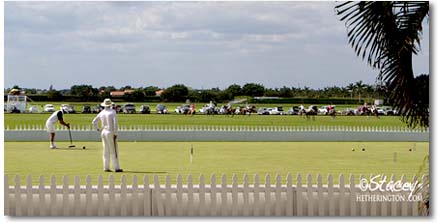
|
| David Openshaw (England) waits for Tony Stephens (New Zealand) to shoot the first hoop in the round-robin phase of the event, while polo ponies gallop down the field below. |
Casual conversation with local croquet pro David Bent and David McCoy, acting general manager of the National Croquet Center and also a Polo member, generated an agreement that this event should be a true invitational, and that the game should be Golf Croquet.
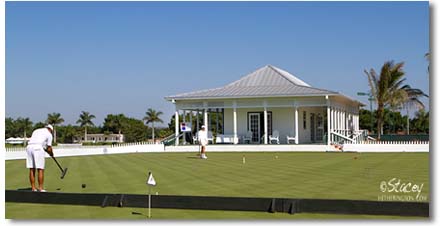
|
| David Maloof (shooting) in his first major golf croquet competion, played fellow croquet pro David Bent (watching from the north side) twice, beating him in their semifinals match. |
Jacobson didn't actually say "show me," but as host, he needed the assurance that Golf Croquet was the winning ticket for his event. In the course of consulting with some of the big players in the sport, we tried to offer that assurance.
One of those "big players" is David Openshaw, who made the surprising suggestion that the event should use Egyptian balls. David Openshaw had played in two major events in Egypt in the fall, and he'd done well in both of them (which put him on our short list), reporting with his typical cheerful confidence that the Egyptian balls - incredibly hard and resilient - actually made for a better game: better for the sound they made when colliding, but especially better for the spectacular transfer of energy that took place on most direct ball-to-ball hits.
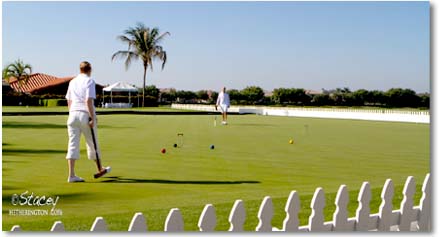
|
| Rachel Rowe, the final addition to the English contingent, was by far the youngest player, at 21, replacing Reg Bamford, who had to withdraw. Her 7-1 shellacking of Egyptian-American Sherif Abdelwahab on the first morning of competition proved beyond doubt her ability to compete with the big boys. |
As editor of CROQUET WORLD, I was attracted to the idea of using Egyptian balls, because it would be something new, something never done in a major event outside Egypt. So with the support of the two Davids (Bent and McCoy) and with the tacit support of Egyptian-trained Mohammad Kamal, whom I'd enlisted as tournament director, knowing that he could communicate well with the Egyptians, I suggested it to Don Jacobson, who at first said he'd prefer using an American-made ball. We said that the only American-made ball approved by the World Croquet Federation is livelier than the Dawson and the Sunshiny (currently the top two), but not in the same class as the Egyptian balls for their reactivity.
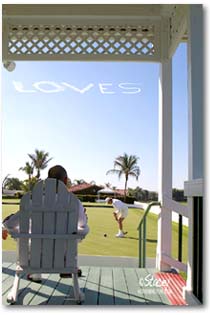
|
| The Sports House porch affords ideal viewing of David Bent's jump shot. The high white plywood barrier provides extra protection from high-flying Egyptian balls. The sky-writing about Jesus didn't last long in the wind, but clearly all the gods smiled upon the event, completed in perfect weather every day. |
David Bent borrowed some balls from croquet pro Len Canavan, based in Florida and long-time head of the USCA's Golf Croquet Committee. With McCoy, we went out to the Polo lawn and did a hit-and-compare session with Dawsons and the Egyptian balls. Wow! What a difference!
Don agreed that the Egyptian balls would make a splash. So it was a go. We'd have to construct special barriers around the lawn to make sure no one would be injured by hard-hit balls (especially by the Egyptian players), but that would be great publicity for the event.
By that time, most of the field was confirmed, and I sent out an email to all the invitees warning they that we would be using Egyptian balls, and that they could withdraw without prejudice if that made a difference to them on the negative side. No one withdrew.
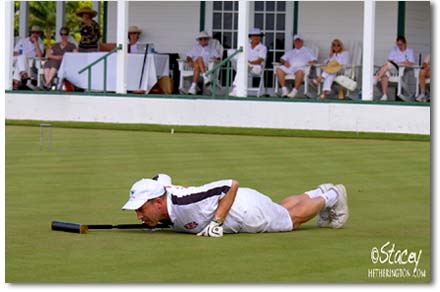
|
| Mulliner's meticulous show of concentration combined with athletic moves usually draws the full attention of the gallery. At times, Mulliner makes croquet look like a sport. |
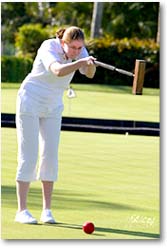
|
| The pigeon-toed stance of Rachel Rowe is distinctly Egyptian - to protect the ankles from faulty swings on hard hits - but the concentration is British. |
This event is produced in the middle of South Florida's high season, when everyone in most other croquet countries wants to visit here to get away from their own winters. The amenities include a bounteous breakfast and lunch for the players poolside - including an excessive gourmet feast on the final day - and all the polo you could stand watching on your off-time.
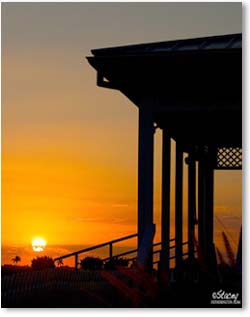
|
| Photographer Stacey Hetherington never needed to stay til sundown, because all the games ended well before then. But she can't resist a perfect sunset, and neither can we. |
It's true that the Egyptian champions didn't come this year, but was that really a bad thing for the tournament? Probably not. Our big worry was that the Egyptians would wipe out the field and take everything away. As it turned out, any one of the eight could have won this tournament, and the top players around the world are improving almost daily to meet the standard of the Egyptians. We'll see in February of 2012 how well they've succeeded.
Award-winning British photographer Stacey Hetherington resides in two equine capitals - Wellington, Florida, and Buenos Aires, Argentina. Although she is best known in exhibits and photography publications for her photographs of thoroughbred racing and polo in the Americans, her work covers many subjects reflecting her extensive travels around the globe, most recently in Outer Mongolia. She maintains a portrait studio in Wellington and teaches photographic workshops. As a member of the International Polo Club Palm Beach, she was ideally positioned to photograph the croquet invitational. You can link directly to all 97 of her photos of the event.